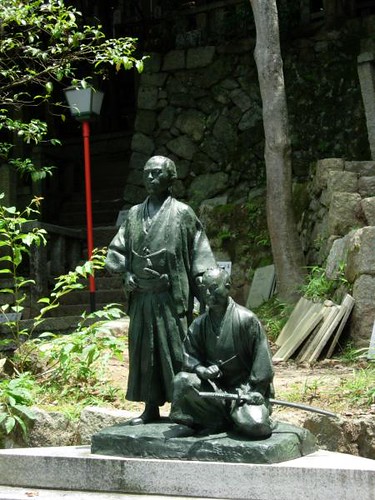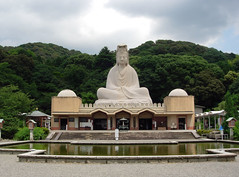
Tässä linkki kuviin, joiden avulla arvoitus ratkesi.
 Kyseessä ovat sotasankarit Sakamoto Ryoma ja Nakaoka Shintaro. Heidän lisäkseen hautausmaalla lepäävät tuhannet muut Meiji-restauraation levottomuuksissa henkensä heittäneet ja lisäksi erilukuinen määrä sekalaisten sotien ja selkkausten vainaita. Toiselle maailmansodalle ei Gokokussa ole juurikaan uhrattu kiveä, sillä rinteen alla sijaitsee erikseen buddhalainen muistomerkki tuntemattomalle sotilaalle.
Kyseessä ovat sotasankarit Sakamoto Ryoma ja Nakaoka Shintaro. Heidän lisäkseen hautausmaalla lepäävät tuhannet muut Meiji-restauraation levottomuuksissa henkensä heittäneet ja lisäksi erilukuinen määrä sekalaisten sotien ja selkkausten vainaita. Toiselle maailmansodalle ei Gokokussa ole juurikaan uhrattu kiveä, sillä rinteen alla sijaitsee erikseen buddhalainen muistomerkki tuntemattomalle sotilaalle."Spirit-inviting-shrine." Prior to World War II, this term referred to shrines established for the purpose of appeasing the spirits of loyalist soldiers who died in the battles of the Meiji Restoration, and thus antecedents of shrines later called gokoku jinja. Both national and private shōkonsha existed, with expenses of the former being compensated in part by set funding provided from the national treasury. --- In short, this notice ordered the establishment of means for the appeasement of the spirits of those who had given their lives on behalf of the nation. Another notice issued at the same time provided for "a new shrine in the Higashiyama district" of Kyoto, a shrine which would become the Kyoto Reizan Gokoku Jinja. These notices thus led to the establishment of shōkonsha (spirit-inviting shrines), shōkonjō (spirit-inviting sites), and graveyards for the entombment of fallen soldiers throughout the nation. In 1869, the Tokyo Shōkonsha was established, and its dedicatory services jointly enshrined the spirits of some 3,588 souls who had recently fallen in the civil war (called the Boshin War) of 1868.
Ryoma taisteli Tokugawa-sotilashallintoa vastaan ja auttoi Meiji-restauraation alulle. Keisarillisen vallan palauttamisen lisäksi Ryoma otti mallia Yhdysvalloista ja uskoi maailman olevan parempi paikka ilman tiukkaa kastiyhteiskuntaluokkajärjestelmää. (Ironisesti Yhdysvallat toivatkin demokratiaa Japaniin omalla tyylillään seuraavalla vuosisadalla...)
Shogunaatin salainen poliisi murhasi Ryoman useiden epäonnistuneiden yritysten jälkeen lopulta Teradaya-nimisessä majatalossa. Voihan sitä historiallista ryokania näinkin mainostaa:
You can still visit or even stay in this room to see the marks of swords and pistols in the pillars from when Ryoma was also attacked and wounded in the Teradaya Incident on the 23rd of January. You can also see the stairs next to the Plum Room which Oryo, Ryoma's girlfriend, used in order to alert (but he survived) him to the attack (she rushed out of her bath and went upstairs, still naked). It is said that Ryoma and Oryo later had the first honeymoon in Japan, as he needed the time to treat his wounded hands with the help and permission of Saigo Takamori. You can see where Oryo used to use the bath tub.

Kommentit
Tämän blogin kommentit tarkistetaan ennen julkaisua.